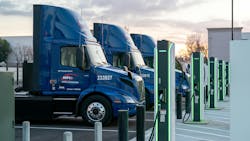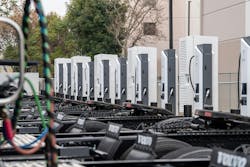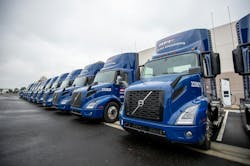NFI opens 'first-of-its-kind' charging depot in SoCal
NFI Logistics recently celebrated a milestone—opening its first electric charging depot near its Ontario, California, warehouse. The facility includes 38 350 kW high-speed chargers—that can charge two heavy-duty trucks simultaneously—and an electric truck maintenance facility.
About the Fleet
-
NFI Industries
-
HQ: Camden, New Jersey
-
FO 500: For-Hire: No. 33
-
Type: General freight
By the end of the year, the facility “will have one megawatt of solar and seven-megawatt hours of battery [storage], as well,” Jim O’Leary, NFI’s VP of assets, said. “We'll operate a little bit like a microgrid.”
The magnitude and capability of this project are testaments to the partnerships necessary to build it. Through funding partnerships, infrastructure partnerships, and partnerships with EV truck manufacturers, NFI (No. 33 on the FleetOwner 500: For-Hire list) built a depot that O’Leary believes is like none other.
“That's seven megawatts of power that we have the capability of charging simultaneously throughout those 38 chargers, plus all those distributed energy resources,” O’Leary told FleetOwner. “I think that combination makes it a first-of-its-kind site in Southern California, and maybe even North America, for that matter.”
It takes time to build out a charging depot
Although it opened only recently, O’Leary said the depot was three and a half years in the making. During the initial planning stages, he and his team agreed that, if the depot was to support 50 to 60 electric vehicles, that was enough to warrant a maintenance facility—because that’s how NFI plans its diesel truck depots.
The team also wasn’t sure how electric trucks would evolve, and they assumed NFI would begin maintaining electric trucks soon into the future, O’Leary said—that’s how the depot’s “e-maintenance shop” came to be.
NFI has an electric fleet of 30 Freightliner eCascadia and 20 Volvo VNR electric trucks. Both manufacturers currently prefer to handle EV maintenance at their facilities. Therefore, NFI’s e-maintenance shop is used primarily as a diagnostics facility and to maintain “wearable items” on the electric trucks, O’Leary said.
See also: Volvo shows off how all-new VNL is designed to make fleets more green
O’Leary said the time it took to build the facility was a learning process. “When you try to scale this technology at this point, we ran into challenges—some expected, some unexpected.”
NFI expected challenges when coordinating with its utility provider and integrating solar power and battery storage at its facility, O’Leary explained, but what it didn’t expect were COVID-19's lingering effects on the global supply chain.
“The biggest issue that we had was a worldwide shortage of medium voltage switchgear,” O’Leary told FleetOwner. “We needed to use medium voltage switchgear on this project because of the complexities.”
NFI expected a 12-month lead time on the switchgear, but that doubled into a 24-month lead time. Another effect of Covid was the increased costs of "everything,” O’Leary said.
“It was one of those projects that there were a lot of hurdles to jump over,” he said.
Why build a depot this impressive?
NFI had multiple reasons to begin its electrification journey and build this state-of-the-art charging depot. These reasons could be summed up as being on the leading edge of technology, being socially responsible, and being resilient, O’Leary said.
What got the ball rolling was when the Tesla Semi was first announced. O’Leary said NFI began talking to its OEM partners about the reality of having electric trucks in the NFI fleet and discovered that drayage—a significant area of NFI’s business—was the perfect fit for heavy-duty electric trucks. When the team learned that electric trucks could work for their company along with the introduction of California’s emissions regulations and available incentives, NFI saw the opportunity to be on the leading edge of the EV transition, O’Leary told FleetOwner.
See also: Phase 3 of the Clean Trucks Plan: A tale of two trucking perspectives
Additionally, one of NFI’s core values is “social responsibility and taking care of the communities that we live in,” O’Leary noted. To NFI, electrifying its fleet was one way to give back to the community where its millions of square feet of warehouse space is located. O’Leary said NFI operates in communities that are “disadvantaged” in air quality, and “we are such a heavy presence in that area, it was just an opportunity to take care of those communities that we operate in.”
Finally, NFI wanted to future-proof its operations by looking ahead.
“We didn’t want to just build a site that would meet the needs of... today,” O’Leary said. “We wanted to future-proof it in a way where we would be able to make the upgrades necessary as technology (advanced). But then we also want it to be a little bit resilient.”
The need for resiliency is the reason why the facility will have battery storage capacity and solar energy generation at its depot when fully completed. NFI wanted to function in the event of a power outage, run off battery power during the day when electricity demand is high, and use electricity to charge the battery at night when demand is low.
EV milestones require industry partnerships
It’s not easy to electrify a fleet. It takes a lot of planning and preparation. NFI is a family-owned and operated company that’s been around for 92 years. The company has roughly 5,000 tractors, 15,000 pieces of trailering equipment, 17,000 employees, and 70 million square feet of warehouse space in North America. With all its resources and bandwidth, O’Leary said even NFI couldn’t have accomplished this task without the help of its partners.
See also: Class 8 EVs found their perfect fit in this Southeast fleet
His advice to other fleets, particularly smaller fleets with fewer resources, is to start early and establish partnerships. NFI found support with its infrastructure buildout, electric truck manufacturer partners, utility partners, and funding partners to help ensure ROI, O’Leary told FleetOwner. One such partner was Electrify America, which helped with infrastructure buildout.
“Electrify America and NFI are aligned in our vision for a sustainable future, and our combined leadership is making real impact for zero-emission trucks,” Robert Barrosa, Electrify America president and CEO, said in a press release.
Another partner was the Joint Electric Truck Scaling Initiative, which helped provide project funding through the California Energy Commission and the California Air Resources Board.
“It's a milestone for us in sustainable transportation and zero emissions freight movement,” O’Leary concluded. “It's one that wouldn't be possible if it weren’t for a group of like-minded partners coming together with the common goal.”
About the Author
Jade Brasher
Senior Editor Jade Brasher has covered vocational trucking and fleets since 2018. A graduate of The University of Alabama with a degree in journalism, Jade enjoys telling stories about the people behind the wheel and the intricate processes of the ever-evolving trucking industry.



